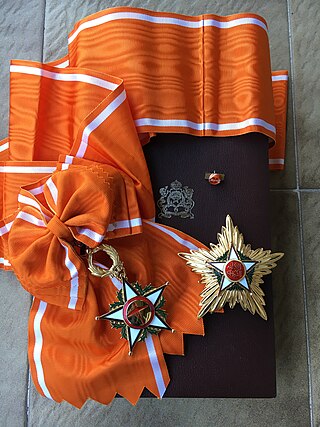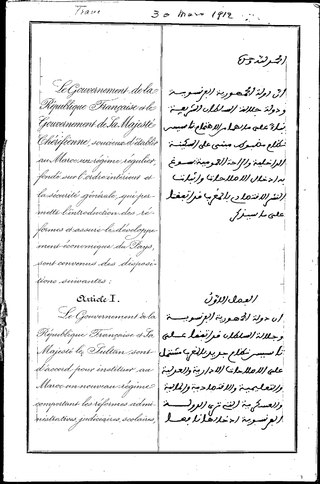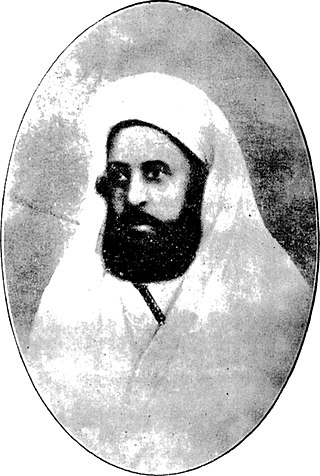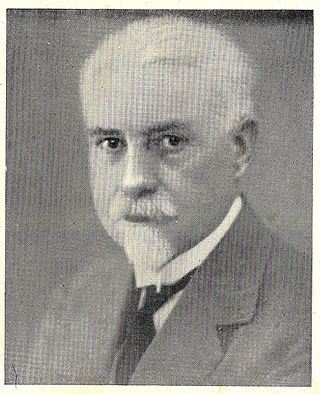
The Lumière brothers, Auguste Marie Louis Nicolas Lumière and Louis Jean Lumière, were French manufacturers of photography equipment, best known for their Cinématographe motion picture system and the short films they produced between 1895 and 1905, which places them among the earliest filmmakers.

The Order of Ouissam Alaouite or the Sharifian Order of Al-Alaoui is a military decoration of Morocco which is bestowed by the King of Morocco upon those civilians and military officers who have displayed heroism in combat or have contributed meritorious service to the Moroccan state. The decoration was established on 11 January 1913 in replacement of the Order of Ouissam Hafidien. It is awarded in five classes: Grand Cordon, Grand Officer, Commander (Commandeur), Officer (Officier) and Knight (Chevalier).

The Treaty of Fes, officially the Treaty Concluded Between France and Morocco on 30 March 1912, for the Organization of the French Protectorate in the Sharifien Empire, was a treaty signed by Sultan Abd al-Hafid of Morocco under duress and French diplomat Eugène Regnault on 30 March 1912. It established the French protectorate in Morocco, and remained in effect until the Franco-Moroccan Joint Declaration of 2 March 1956.

MawlayHassan bin Mohammed, known as Hassan I, born in 1836 in Fes and died on 9 June 1894 in Tadla, was a sultan of Morocco from 12 September 1873 to 7 June 1894, as a ruler of the 'Alawi dynasty. He was proclaimed sultan after the death of his father Mawlay Muhammad bin Abd al-Rahman. Mawlay Hassan was among the most successful sultans. He increased the power of the makhzen in Morocco and at a time when so much of the rest of Africa was falling under foreign control, he brought in military and administrative reforms to strengthen the regime within its own territory, and he carried out an active military and diplomatic program on the periphery. He died on 9 June 1894 and was succeeded by his son Abd al-Aziz.

Mohammed Ben Aarafa, or Ben Arafa, was a paternal first cousin once removed of Sultan Mohammed V of Morocco; he was put in Mohammed V's place by the French after they exiled Mohammed V to Madagascar in August 1953. His reign as "Mohammed VI" was not recognized in the Spanish-protected part of Morocco. Protests against Ben Aarafa helped lead to Moroccan independence, which was agreed to between France and Mohammed V, after his abdication in October 1955.

Jean-Philippe Charbonnier was a French photographer whose works typify the humanist impulse in that medium in his homeland of the period after World War II.

Ahmed Balafrej was the second Prime Minister of Morocco between May 12, 1958, and December 2, 1958. He was a significant figure in the struggle for the independence of Morocco.
Carga de rurales is an 1896 Mexican short black-and-white silent documentary film directed by Gabriel Veyre, who was born in France but is known mainly for his work in Mexico, Indochina and Morocco.

The Cimetière Saint-Pierre is the largest cemetery in the city of Marseille, Southern France.

Sol Hachuel was a Moroccan Jewish woman who was publicly beheaded for refusing to convert to Islam at the behest of the erstwhile Moroccan sultan Abd al-Rahman. She was executed in 1834, at the age of 17, after being charged with apostasy from Islam — apparently without ever having converted. According to The Jewish Encyclopedia, Hachuel "was a martyr to her faith, preferring death to become the bride of the sultan"; she is considered a tzadeket (saint) by some Jews and is also revered by some Muslims. Jews call her Sol HaTzaddikah, while Arabs call her Lalla Zuleikha.
The Battle of Wadi al-Laban occurred in March–April 1558 between Saadians and Ottoman Algerian forces under Hasan Pasha, the son of Hayreddin Barbarossa. It took place north of Fes, at Wadi al-Laban, an affluent of the Sebou River, one day north of Fes.

Mounir Majidi is a Moroccan businessman. He has been the personal secretary of King Mohammed VI since 2000 and president of the royal holding, SIGER, since 2002. He is also the president of Maroc Culture, the organization behind the Mawazine festival, of the Fath Union Sport (FUS) Rabat, of the Mohammed VI soccer academy, and of the Cheikh Zaid hospital's foundation.

Bernard Boutet de Monvel was a French painter, sculptor, engraver, fashion illustrator and interior decorator. Although first known for his etchings, he earned notability for his paintings, especially his geometric paintings from the 1900s and his Moroccan paintings made during World War I. In both Europe and the United States, where he often traveled, he also became known as a portrait painter for high society clients.

The Principality of Debdou was an autonomous hereditary viceroyalty that existed in eastern Morocco from 1430 to 1563, with its capital at Debdou. It was governed by the Ouartajin, a dynasty of Berber descent, related to the Marinids and Wattasids.

Amédée Marie Joseph Paul Révoil was a French diplomat and administrator who represented France in Morocco (1896–1901), was Governor General of Algeria (1901–1903) and was French ambassador to Switzerland (1906) and Spain (1907–09). He is known for his role in moving towards a peaceful extension of French influence in Morocco.
Fatiha Mohamed Taher Mejjati is a Moroccan jihadist. She is the widow of Karim Mejjati, co-founder of the Moroccan Islamic Combatant Group and member of Al-Qaeda. Karim Mejjati is suspected of planning the 2003 Casablanca bombings and the 2004 Madrid train bombings.

Muhammad ibn al-'Arabi at-Torres was a diplomat, representative of the sultan in Tangier, and foreign minister of Morocco at the turn of the 20th century. He was present at the 1906 Algeciras Conference, which established French preëminence among European powers in Morocco.

The Battle of Moulouya took place in May 1692 at a ford on the Moulouya river in Morocco. It was fought between the armies of the Alaouite Sultan Moulay Ismail and those of the Dey of Algiers Hadj Chabane.

Frédéric Weisgerber was a French colonial doctor and cartographer active in Morocco before and during the French Protectorate. In 1904, he wrote a book entitled Trois mois de campagne au Maroc: étude géographique de la région parcourue about his three-month participation in a campaign in Morocco in the winter of 1898.

Si El Madani El Glaoui, born Madani El Mezouari El Glaoui, nicknamed the faqih was a prominent statesman in Morocco during the late 19th century and early 20th century. He was largely responsible for establishing the Glaoui family's power in the country.


















